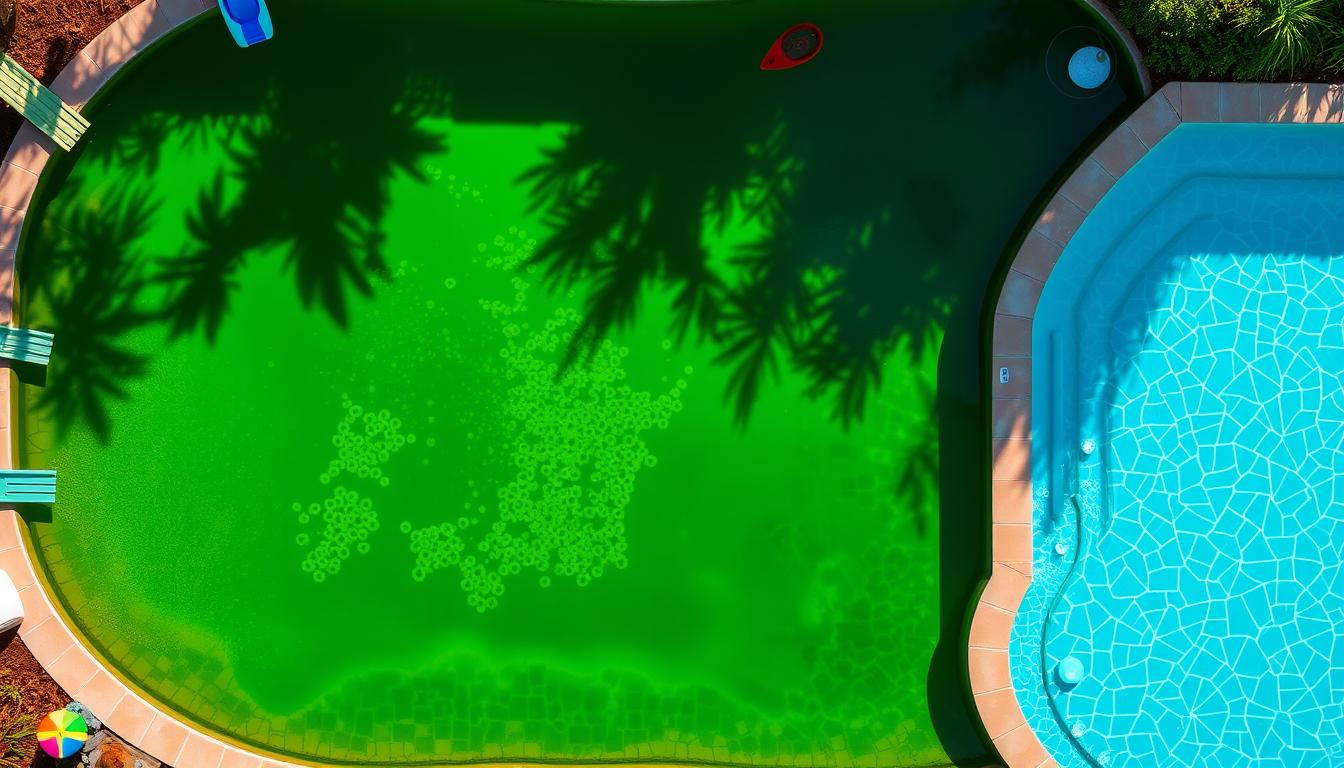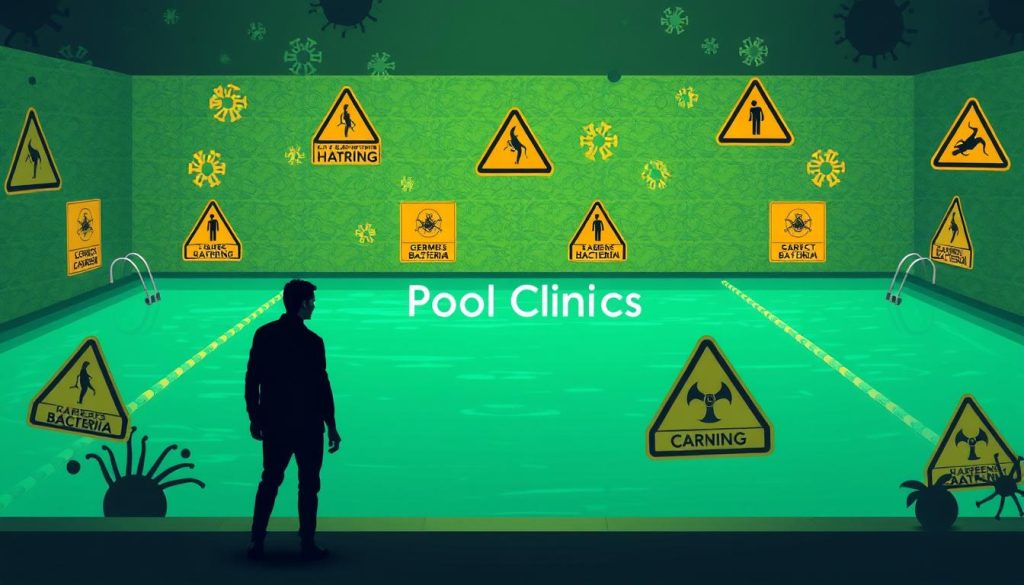
Summer heat often tempts us to cool off in a pool. But what if the water is green? This color change signals poor water quality. It could mean algae growth or chemical imbalance. These conditions breed harmful bacteria and germs.
Green pools can pose serious health risks. Swallowing contaminated water may cause diarrhea. Skin irritations and respiratory infections are also possible. Children, pregnant women, and those with weak immune systems face higher risks.
Understanding pool sanitation is crucial for safe swimming. Recognizing warning signs helps protect our health. With proper care, we can enjoy a refreshing and safe swim.
Key Takeaways
- Swimming in a green pool can lead to various health risks due to poor water quality and the presence of harmful bacteria.
- Pools turn green when there is an imbalance in chemicals, inadequate cleaning, or issues with filtration systems.
- Algae growth in pools can lead to slippery surfaces, poor visibility, and the rapid growth of bacteria.
- Ingesting or coming into contact with contaminated pool water can cause illnesses such as diarrhea, skin rashes, and respiratory infections.
- Proper pool hygiene and chemical balance are essential to prevent algae growth and ensure a safe swimming experience.
Understanding the Risks of Swimming in a Green Pool
Green pools can be dangerous for swimmers. Algae growth causes water discoloration and creates a perfect environment for harmful bacteria. These pools can harbor pathogens that lead to serious illnesses.

Common Waterborne Illnesses Associated with Green Pools
Green pools can breed various pathogens, including E. coli, Giardia, and Cryptosporidium. These microorganisms can cause a range of illnesses.
- Gastrointestinal issues: Accidentally ingesting contaminated pool water can lead to symptoms like nausea, vomiting, stomach cramps, diarrhea, and fever.
- Skin problems: Swimmers may develop itchy skin, rashes, hives, or even dermatitis, characterized by swelling, redness, and blister formation.
- Respiratory issues: Bacterial growth in green pools can cause difficulty in breathing or coughing.
- Eye and ear infections: Exposure to contaminated water can result in red, itchy, and watery eyes, as well as swimmer’s ear.
The severity of these illnesses depends on your immune system. It also depends on how dirty the pool is.
Groups at Higher Risk for Swimming-Related Illnesses
Some people are more likely to get sick from green pools. These groups include children, the elderly, pregnant women, and those with weak immune systems.
| High-Risk Group | Reasons for Increased Susceptibility |
|---|---|
| Children | Developing immune systems and tendency to swallow more water while swimming |
| Elderly | Weakened immune systems due to age or underlying health conditions |
| Pregnant Women | Changes in immune function during pregnancy |
| Immunocompromised Individuals | Reduced ability to fight off infections due to medical conditions or treatments |
To stay safe, keep your mouth closed while swimming. Always shower before entering the pool. Don’t swim if you’ve had diarrhea in the last two weeks.
By knowing the risks of green pools, we can take steps to protect ourselves. This way, we can enjoy swimming while staying healthy.
Diarrheal Illnesses Transmitted Through Contaminated Pool Water
Diarrhea is a common swimming-related illness caused by waterborne germs. These include Cryptosporidium, Giardia, Shigella, norovirus, and E. coli. Infected swimmers can easily contaminate pool water, putting others at risk.
Cryptosporidium: The Most Common Cause of Pool-Related Diarrhea Outbreaks
Cryptosporidium, or Crypto, is a tough parasite that survives in water for over 7 days. It’s the leading cause of pool-related diarrhea outbreaks in the US.
Even small amounts of Crypto-contaminated water can cause infection. Swimmers should avoid swallowing pool water to stay safe.
| Germ | Survival Time in Water |
|---|---|
| Cryptosporidium | More than 7 days |
| Giardia | Up to 7 days |
| E. coli | Up to 4 days |
| Shigella | Up to 3 days |
| Norovirus | Up to 2 days |
Symptoms and Treatment of Diarrheal Illnesses
Symptoms of waterborne diarrheal illnesses may include:
- Severe abdominal pain
- Watery or bloody diarrhea
- Fever
- Nausea and vomiting
- Dehydration
Most cases of these illnesses resolve on their own within a few days. Rest and hydration are typically the main treatments.
However, severe cases may require medical attention. This is especially true for young children, pregnant women, and those with weak immune systems.
To reduce the risk of spreading diarrheal illnesses, it is essential for swimmers to stay out of the water if they have recently been sick with diarrhea and to practice good hygiene, such as showering before entering the pool and washing hands thoroughly after using the restroom or changing diapers.
Other Health Concerns Associated with Green Pools
Green pools can cause more than just diarrheal illnesses. Other health issues can arise from contaminated water exposure. These conditions may lead to discomfort, pain, and serious complications if untreated.
Hot Tub Rash Caused by Pseudomonas Aeruginosa Bacteria
Hot tub rash, or Pseudomonas folliculitis, is an infection caused by Pseudomonas aeruginosa bacteria. It occurs when skin contacts contaminated water in hot tubs or pools. Symptoms include itchy, red bumps or pus-filled blisters on the skin.
To prevent hot tub rash, ensure pools and hot tubs are properly cleaned. Maintain appropriate disinfectant levels in these water sources.
Swimmer’s Ear: Otitis Externa
Swimmer’s ear, or otitis externa, is an outer ear canal infection. It develops when water gets trapped in the ear after swimming. This creates a moist environment for bacteria or fungi to grow.
Symptoms include itching, pain, swelling, and ear discharge. Dry your ears after swimming to reduce risk. Consider using ear drops with acetic acid or alcohol.
Legionnaires’ Disease: A Serious Lung Infection
Legionnaires’ disease is a severe pneumonia caused by Legionella bacteria. It occurs when people inhale contaminated mist from poorly maintained pools or hot tubs. Symptoms include high fever, cough, shortness of breath, and muscle aches.
Regularly clean and disinfect pools and hot tubs to minimize risk. Avoid breathing in mist from potentially contaminated water sources.







